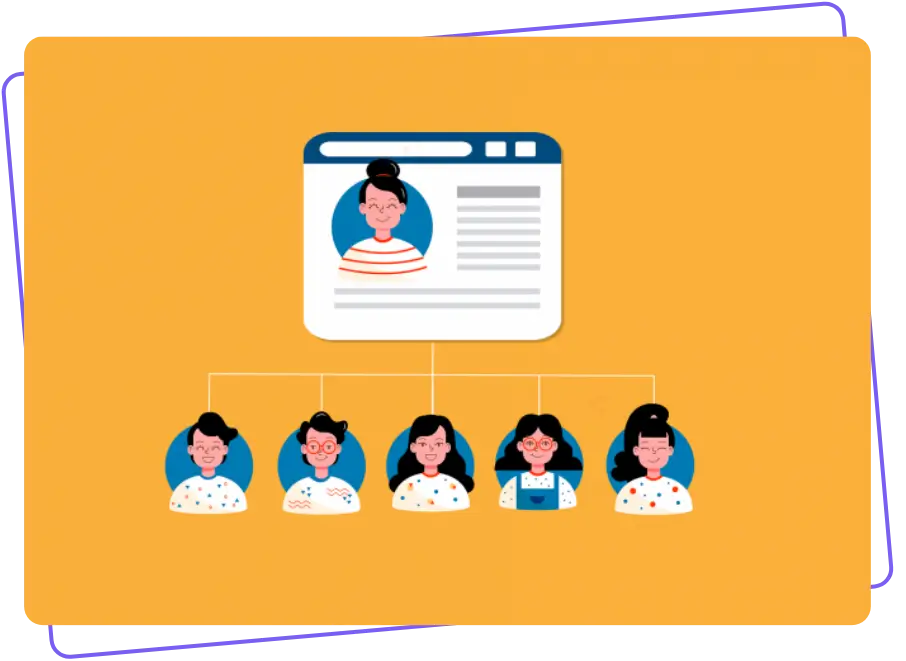Getting to know your clients
Consider this scenario: asking a favour from a family member versus asking a favour from a work colleague. The way you approach each of these conversations is going to be quite
different. You’ll use different words, phrases and tone to make your pitch and hopefully get that favour taken care of. And you’ll do this because you know that you’re speaking to two quite different audiences and knowing what each of them is like, you’ll change what you say and how you say it to make it more appealing and appropriate.
Buyer personas help you do this on a bigger scale with your care marketing. They help you get to know your ideal client, their needs and their wants. So when you have a “conversation” with a real prospect — whether you’re speaking to them through your website, emails or social posts — you’ll have nailed the message and tone.
Ultimately, it’s easier to write anything, from a blog to a Facebook post, when you’re writing to an individual. And when that individual represents your ideal care customer, you’ll end up
connecting with a great many more prospects on a much more personal level. You’ll sound as if you’re speaking directly to them, rather than to a crowd.
Telling a story
A buyer persona can be based on existing trends in your current care client base or on trends in the care client base you want to target but currently doesn’t make up much of your business.
A well-written buyer persona will cover basic demographic information, personal history, family set-up, motivations and pain points. Here is how a buyer persona for care might start:
“Sarah is a 54-year-old woman born on December 20 1967 in Kingston, Surrey. She went to Castle Hill Primary School followed by Hollyfield secondary school. After college, she studied for a degree in Human Resources Management at Roehampton University.”
It would go on to describe her career, where she met her partner and her family setup then and now…
“…Sarah’s mum, Sally, was always on hand to help with childcare while Sarah went back to work after her maternity leave. Sarah’s children, Stephanie (25) and Jack (22) are now working
themselves in London…”
It would describe Sarah’s family growing up, the current health of her ageing mother, as well as Sarah’s career, income and financial outgoings. It would also go on to talk about Sarah’s lifestyle…
“…Sarah loves watching Bake Off and chatting about it with her daughter when they meet up once a week. Outside of work, she enjoys going for walks in Richmond Park and curling up with a good “beach read” at night in bed… Sarah visits her mum at least twice a week and always does the weekly shop with her, making sure to pick up their favourite guilty pleasure, a packet of coconut macaroons.”
After covering where Sarah gets her news from, how technology-savvy she is and which social media platforms she uses, the buyer persona will finally get into the nitty-gritty of what Sarah’s current situation is and why she is looking for professional care for her mum Sally:
“…Sarah wants to find a carer who can take Sally out for regular walks to help with her
osteoarthritis, will make sure she takes her diabetes medication on time and make sure doesn’t miss any meals… Sarah is looking for specialist care, as well as companionship care for her very sociable mum and wants a care agency that will communicate with both herself and her mum equally, as Sally is still very much capable of making her own decisions but
appreciates Sarah’s support and advice…”
These are just the highlights of a buyer persona for care but as you can see it’s a detailed story that gives a real sense of who this fictional client, Sarah, is. And this makes it much easier to write content and create marketing messages that hit the mark.
But couldn’t speaking to one imaginary person end up excluding lots of real potential care clients?
Exclusion versus inclusion
It’s important to remember that while your buyer persona describes an individual person, it represents common characteristics of a significant portion of your ideal clients. This ensures that your marketing stirs a feeling of inclusion in your prospects as your message is meant for them and others just like them who are looking for trusted care services.
This doesn’t mean that your marketing excludes other potential clients, it simply isn’t highly targeted towards them. Plus, when you create multiple buyer personas, you can use these to create messages that target different groups of clients or, in marketing-speak, different
customer segments.
For starters, it’s best to create one or two buyer personas that represent your key target care clients. If you later decide to target a slightly different group of clients or expand your offering to include an additional care service, you can revisit these buyer personas or create new ones to hone your marketing and make every word count.






 Find and click three bananas hidden on our site for a chance to win a full care marketing health check worth ₤175!
Find and click three bananas hidden on our site for a chance to win a full care marketing health check worth ₤175! 